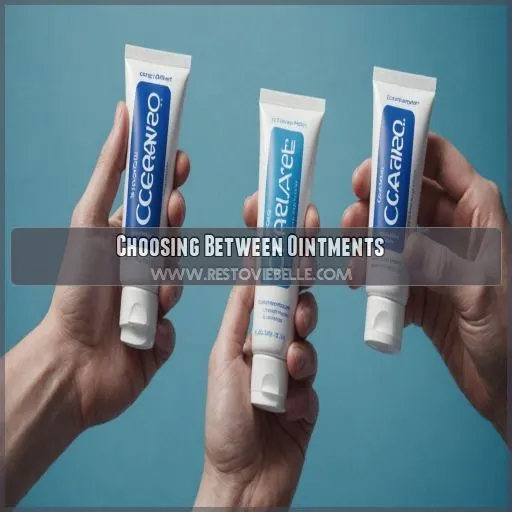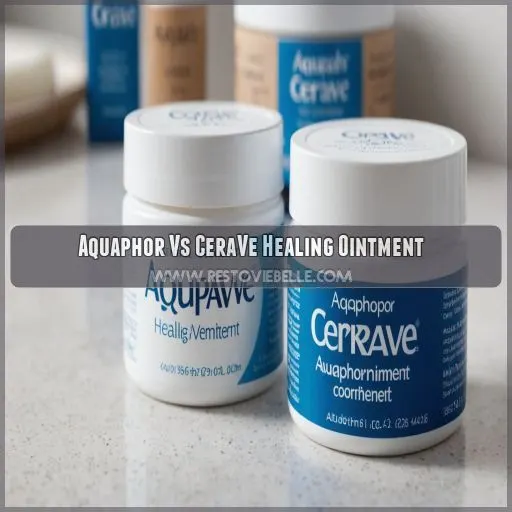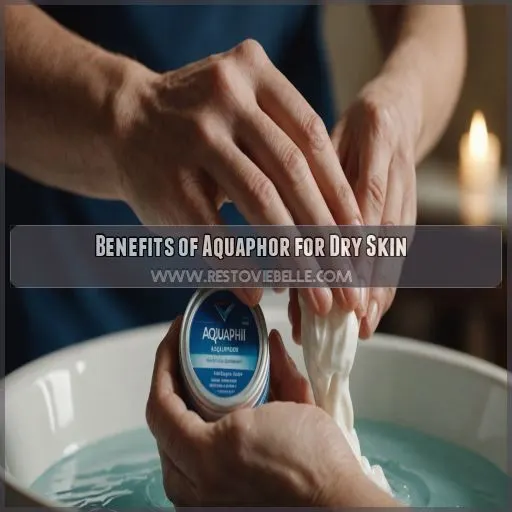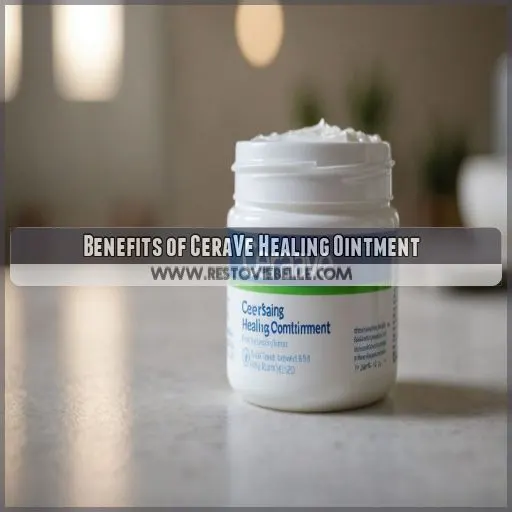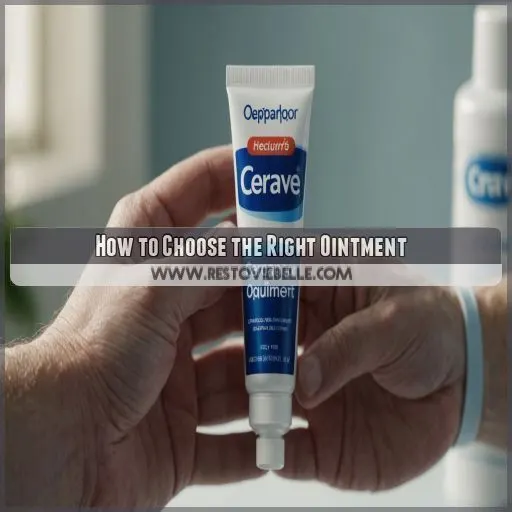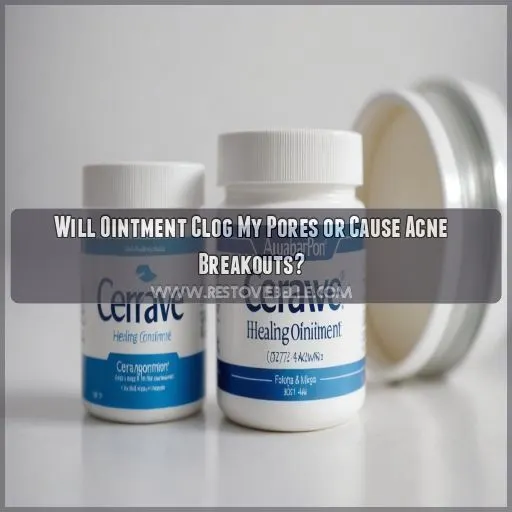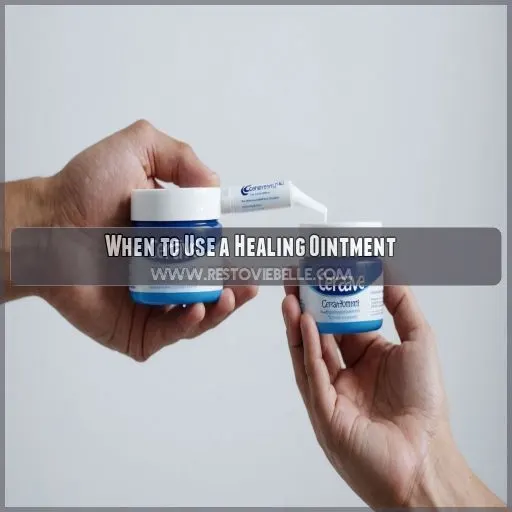This site is supported by our readers. We may earn a commission, at no cost to you, if you purchase through links.
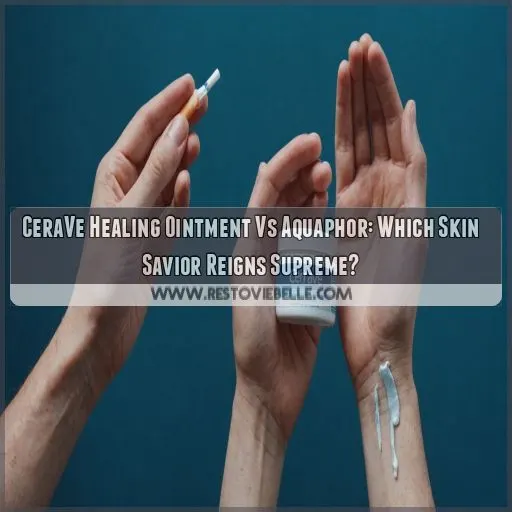 When choosing between CeraVe Healing Ointment and Aquaphor, consider your skin’s specific needs.
When choosing between CeraVe Healing Ointment and Aquaphor, consider your skin’s specific needs.
Aquaphor, your trusty kitchen sink of skin saviors, creates a thick, protective barrier perfect for severely dry skin and eczema. It’s like wrapping your skin in a cozy blanket, but it can feel greasy.
On the lighter side, CeraVe’s non-greasy formula is best for sensitive or acne-prone skin, as it repairs the skin barrier with ceramides and hyaluronic acid. It’s like a gentle hug for your skin!
Table Of Contents
- Key Takeaways
- Choosing Between Ointments
- Aquaphor Vs CeraVe Healing Ointment
- Benefits of Aquaphor for Dry Skin
- Benefits of CeraVe Healing Ointment
- How to Choose the Right Ointment
- Will Ointment Clog My Pores or Cause Acne Breakouts?
- When to Use a Healing Ointment
- Frequently Asked Questions (FAQs)
- Is CeraVe Healing Ointment or Aquaphor better?
- What’s better than Aquaphor?
- Why do dermatologists recommend Aquaphor?
- What is the benefit of CeraVe Healing Ointment?
- Are Aquaphor and CeraVe vegan-friendly?
- Do Aquaphor and CeraVe contain parabens?
- What skin types are best suited for Aquaphor?
- Can CeraVe Healing Ointment be used on tattoos?
- How often should I apply these ointments?
- Conclusion
Key Takeaways
- Trying to pick between CeraVe and Aquaphor? Think of your skin’s needs like your favorite blanket: Aquaphor’s heavy-duty protection is perfect for dry, cracked skin, while CeraVe’s lightweight approach suits sensitive, acne-prone types.
- Both ointments pack a punch in their ingredients: Aquaphor uses lanolin alcohol and panthenol, keeping your skin snug as a bug, whereas CeraVe’s got ceramides and hyaluronic acid, strengthening your skin’s natural barrier like a fortress.
- Don’t sweat the prices; they’re both budget-friendly. It’s more about asking yourself: Do you need heavy-duty hydration or a gentle touch? Like choosing between comfy slippers and a pair of trainers!
- If you’re battling dry patches or soothing new ink, these ointments are versatile heroes. Just pick your trusty sidekick: Aquaphor is your go-to for hardcore dryness, while CeraVe’s perfect for gentle nurturing. Think of it as choosing between Batman and Robin.
Choosing Between Ointments
When you’re staring at a shelf full of ointments, choosing the right one can feel as tricky as picking a favorite flavor at an ice cream shop. Let’s explore the key differences between Aquaphor and CeraVe together, so you can find your skin’s perfect match.
Key Differences Between Aquaphor and CeraVe
Not sure which ointment to choose, Aquaphor or CeraVe? Let’s break it down:
- Texture: Aquaphor’s thick, occlusive barrier is great for dry, cracked skin, while CeraVe’s lighter formulation is better for sensitive skin CeraVe user ratings.
- Ingredients: Aquaphor’s lanolin alcohol and panthenol lock in moisture. CeraVe has ceramides and hyaluronic acid that support the skin barrier.
- Price & Usage: Both are budget-friendly with versatile uses, but it’s all about your skin’s needs!
Benefits of Each Ointment for Specific Skin Concerns
So, you’ve compared Aquaphor and CeraVe Healing Ointment. Now let’s match them to your skin’s needs.
Got eczema, psoriasis, or chapped lips? Aquaphor’s your heavyweight champ for severely irritated skin.
Fighting dry hands or nurturing baby skin? CeraVe’s got you with its non-greasy, lightweight formula.
It’s like choosing between a cozy blanket and a breezy summer day. Each ointment offers unique charms to soothe your skin barrier.
Ingredients to Look for in a Healing Ointment
You’ve seen how Aquaphor and CeraVe shine for different skin issues; now, let’s peek inside their tubes. Key ingredients make all the difference in a healing ointment:
- Ceramides: Guards your skin like a bouncer at a club, maintaining moisture.
- Hyaluronic Acid: A moisture magnet, leaving skin plump.
- Petrolatum: Provides a barrier as strong as Fort Knox.
- Emollients & Anti-Inflammatories: Soothe and heal with a gentle touch.
Aquaphor Vs CeraVe Healing Ointment
If you’re looking for a skin-soothing ointment, Aquaphor and CeraVe Healing Ointment are two top contenders worth checking out. Aquaphor boasts a thick, occlusive barrier, making it ideal for severely dry, cracked skin. On the other hand, CeraVe’s lighter texture and ceramide-infused formula cater to sensitive, acne-prone complexions. While both offer impressive results, the choice ultimately depends on your individual skin type and preferences. Consider the key differences in the table below to determine which ointment will be your skin’s new best friend.
| Feature | Aquaphor | CeraVe Healing Ointment |
|---|---|---|
| Texture | Thick, occlusive | Lightweight, non-greasy |
| Key Ingredients | Petrolatum, mineral oil | Petrolatum, ceramides, hyaluronic acid |
| Skin Types | Severely dry, cracked | Sensitive, acne-prone |
| Versatility | Multipurpose (lips, cuticles) | Multipurpose (dry skin, eczema, tattoos) |
Benefits of Aquaphor for Dry Skin
If your skin feels drier than a desert, Aquaphor’s your oasis, providing swift relief and comfort. From chapped lips to rough elbows, this mighty balm has you covered without the greasy aftermath.
How Aquaphor Provides Immediate Relief for Dry Skin
Struggling with dry skin? Aquaphor‘s your knight in shiny ointment!
Its thick, occlusive barrier seals in moisture like Fort Knox, thanks to ingredients like petrolatum and panthenol.
Speedy relief is a guarantee, as it transforms parched patches into hydrated havens.
Whether you’ve got Sahara desert elbows or dried-out winter hands, this healing ointment’s texture offers immediate comfort.
Unlike CeraVe Healing Ointment, it’s built for those truly desperate dry skin moments.
Uses for Aquaphor Beyond Dry Skin
Aquaphor is more than just a soothing balm for dry skin it’s a powerful occlusive.
It can be used as a lip balm to combat chapped lips.
Aquaphor can also be used to soothe eczema.
It can even be used to protect fresh tattoos.
Aquaphor is gentle enough for delicate baby skin.
It can also be used to pamper cuticles.
With Aquaphor, you’re ready for life’s little surprises!
Potential Drawbacks of Using Aquaphor
Feeling bogged down by Aquaphor’s heavy feel? It’s not all sunshine and roses. That thick, occlusive effect can sometimes leave behind a greasy residue, making it feel like you dipped your hands in a jar of butter.
- Texture concerns: It can be tough to spread evenly, especially if you’re in a hurry.
- Greasy residue: Beware, oily surfaces could leave a trail.
- Application tips: Use sparingly to avoid feeling slick.
Benefits of CeraVe Healing Ointment
If your skin needs a little extra TLC, CeraVe Healing Ointment could be your new best friend. Packed with skin-nourishing ceramides and hydrating hyaluronic acid, this lightweight formula helps repair and strengthen your skin’s natural barrier, leaving you with a healthy, radiant glow learn about squalane.
How CeraVe Repairs and Strengthens the Skin’s Barrier
With its potent mix of ceramides and hyaluronic acid, CeraVe Healing Ointment strengthens your skin’s barrier. Imagine it as a fortress against dryness, enhancing moisture retention.
| Benefit | Description |
|---|---|
| Skin Barrier Function | Strengthened and fortified |
| Hyaluronic Acid | Boosts skin hydration |
| Ceramides | Protect and enhance resilience |
| Moisture Retention | Locks in hydration effectively |
| Lightweight Feel | Comfortable and easy to apply |
Your skin thanks you!
Uses for CeraVe Beyond Dry Skin
Beyond dry skin, CeraVe Healing Ointment is your all-purpose hero. Need CeraVe for eczema relief? It’s got you covered. Try it on tattoos, lips, cuticles, or even hair ends—it’s like magic in a tube!
CeraVe’s Non-Greasy Texture and Fragrance-Free Formula
CeraVe’s smooth texture effortlessly glides on, unlike sticky candy on a hot day. This non-greasy, fragrance-free ointment is kind to sensitive, acne-prone skin, making it a safe bet for those seeking comfort without breakouts.
The Importance of Ceramides in Skin Health
Ceramides are skin’s superheroes, fortifying your natural barrier to lock in moisture and prevent irritation. CeraVe’s got your back with this skin-strengthening ingredient – a must-have for dry, sensitive types.
Benefits of Hyaluronic Acid for Skin Hydration
While ceramides bolster your skin’s defenses, hyaluronic acid steps in like a mini water reservoir. Picture it plumping up your skin, smoothing out wrinkles, and tackling dry skin woes. It’s your skin’s hydration hero!
Role of Petrolatum in Locking in Moisture
Imagine petrolatum as a cozy blanket for your skin—it locks in moisture remarkably well.
- Petrolatum’s occlusive properties create a moisture barrier.
- Keeps skin hydrated.
- Great for wound healing and sensitive skin.
- Compares favorably to other moisturizers.
- Non-irritating and soothing.
How to Choose the Right Ointment
Choosing the right ointment for your skin doesn’t have to be an epic saga. Whether you’re battling dryness, acne, or just want a magic potion for your elbows, understanding your skin type and the ointment’s features helps you pick the perfect match without breaking the bank.
Considering Your Skin Type and Needs
When choosing the right ointment, consider your unique skin type and needs. If you have sensitive, acne-prone skin, CeraVe’s ceramide-infused formula may be the better choice. For severely dry, cracked areas, Aquaphor’s thick, occlusive barrier could provide the intense hydration you crave. Assess your specific concerns to find the ointment that will work hardest for your skin.
Evaluating Texture, Versatility, and Special Features
When choosing an ointment, consider how its thickness and special ingredients impact your skin type.
If you’re juggling greasy texture versus application ease, it can feel like deciding between smooth jazz and rock ‘n’ roll.
CeraVe’s lighter texture generally appeals to those who prefer non-greasy options, while Aquaphor offers a dependable heavy-duty barrier.
Comparing Prices and Value for Money
When you’re choosing between CeraVe and Aquaphor, pricing can feel like comparing apples to oranges.
With your wallet in mind, Aquaphor is lighter on the purse strings, offering a high bang for your buck.
However, CeraVe’s additional ingredients could justify its higher price for some.
It really boils down to what you value more: cost-effectiveness or that little extra skin care oomph.
Keep your priorities in check!
Will Ointment Clog My Pores or Cause Acne Breakouts?
Worried about ointments causing acne? Don’t fret—get the scoop on how CeraVe and Aquaphor might affect your pores, so you can keep your skin clear and happy.
Non-Comedogenic Ointments for Acne-Prone Skin
acne-prone skin needs non-comedogenic ointments that won’t clog pores. Look for ointments like CeraVe and Aquaphor that are formulated without pore-clogging ingredients like fragrances, dyes, and heavy oils. These gentle, non-irritating options can hydrate and protect your skin without triggering breakouts. Just apply sparingly and focus on problem areas to avoid any unwanted shine or greasiness.
How to Use an Ointment Without Clogging Pores
Worried about ointments clogging your pores? Fear not! You can safely apply ointment without breakouts by opting for non-comedogenic options like CeraVe.
It’s like giving your skin a comfy sweater, minus the itch.
Always apply a thin layer; a little goes a long way.
Consider ointment alternatives if you’re still uneasy.
Benefits of Using a Fragrance-Free Ointment
Ever wonder why fragrance-free ointments are a smart choice? For sensitive skin, they reduce irritation risks and support eczema relief. Plus, they help avoid allergy prevention pitfalls. Here’s why you’ll love them:
- Sensitive Skin: Less chance of irritation.
- Ingredient Safety: No unnecessary chemicals.
- Allergy Prevention: Fewer triggers for allergic reactions.
- Eczema Relief: Gentle enough for eczema-prone skin.
When to Use a Healing Ointment
You’re wondering, “When should I slather on ointment?” Well, think of it as a shield for those battlefield moments your skin faces daily. Whether it’s tackling dry patches, or soothing chapped lips, a healing ointment’s your trusty sidekick. Here’s when to use it:
Use Ointment When…
| Minor Cuts | Healing and protection |
| Chapped Lips | Immediate relief |
| Eczema Outbreaks | Calming inflammation |
| Diaper Rash | Preventing irritation |
| Dry Patches | Restoring moisture |
Choose wisely, and your skin will thank you!
Frequently Asked Questions (FAQs)
Is CeraVe Healing Ointment or Aquaphor better?
They say, "Different strokes for different folks!" If you want heavy-duty hydration for cracked skin, Aquaphor’s the go-to. Prefer something lighter for sensitive skin? CeraVe Healing Ointment’s your buddy, with ceramides and hyaluronic acid. Choose wisely!
What’s better than Aquaphor?
CeraVe Healing Ointment may be the answer you’re looking for – it’s a lightweight yet deeply hydrating option that won’t leave you feeling greasy. With its ceramides and hyaluronic acid, it’s a game-changer for dry, sensitive skin.
Why do dermatologists recommend Aquaphor?
Dermatologists recommend Aquaphor because it’s like a trusty superhero for your skin creating a protective barrier that locks in moisture and heals dry, cracked patches super-fast, just like using a wide-tooth comb can help detangle and prevent further damage to dry, brittle hair. Its versatility and soothing properties make it a reliable choice.
What is the benefit of CeraVe Healing Ointment?
Think of CeraVe Healing Ointment as a cozy blanket for your skin—it hydrates and protects with ceramides and hyaluronic acid. This non-greasy formula soothes dry, cracked areas, offering comfort like your favorite pair of fuzzy socks.
Are Aquaphor and CeraVe vegan-friendly?
Neither Aquaphor nor CeraVe are100% vegan, as they contain animal-derived ingredients. Aquaphor contains lanolin alcohol from wool, while CeraVe uses cholesterol. Always check ingredients if you’re keen on keeping things vegan-friendly!
Do Aquaphor and CeraVe contain parabens?
If you’re worried about parabens, both Aquaphor and CeraVe products are parabens-free. You don’t have to choose between them based on that, instead focus on texture and your specific skin needs.
What skin types are best suited for Aquaphor?
Aquaphor suits dry, cracked, or irritated skin best—it’s like a trusty shield for rough spots. If you’re battling serious dryness or needing a multipurpose salve, Aquaphor can be your skin’s best buddy in a pinch.
Can CeraVe Healing Ointment be used on tattoos?
CeraVe Healing Ointment is like a gentle armor for your tattoos, helping protect and soothe during the healing process. It’s non-greasy, fragrance-free, and makes a great ally in keeping your ink safe and vibrant.
How often should I apply these ointments?
You’ll want to apply these ointments as needed, usually 1-2 times per day. Start with a small amount and see how your skin responds. Adjust the frequency based on your skin’s hydration needs. A little goes a long way!
Conclusion
Choosing between CeraVe Healing Ointment and Aquaphor is like picking your hero—each has a superpower!
The decision hinges on your skin’s unique demands.
If you’re wrestling with intense dryness, Aquaphor’s rich barrier comes to the rescue.
But for sensitive souls, CeraVe’s lightweight embrace with ceramides is the gentle ally you need.
Consider your skin type, needs, and budget when deciding which skin savior reigns supreme.
Your skin deserves the best; find its perfect match!

